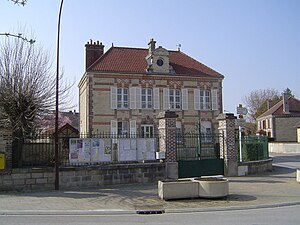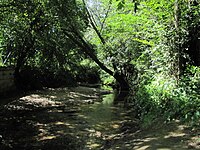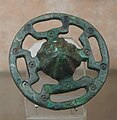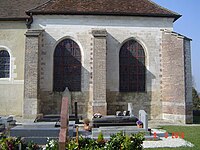Isle-Aumont
| Isle-Aumont | ||
|---|---|---|
|
|
||
| region | Grand Est | |
| Department | Aube | |
| Arrondissement | Troyes | |
| Canton | Vendeuvre-sur-Barse | |
| Community association | Troyes Champagne Métropole | |
| Coordinates | 48 ° 13 ' N , 4 ° 8' E | |
| height | 112-136 m | |
| surface | 3.48 km 2 | |
| Residents | 472 (January 1, 2017) | |
| Population density | 136 inhabitants / km 2 | |
| Post Code | 10800 | |
| INSEE code | 10173 | |
 Mairie Isle-Aumont |
||
Isle-Aumont is a French commune with 472 inhabitants (as of January 1, 2017) in the Aube department in the Grand Est region (until 2015 Champagne-Ardenne ). The municipality belongs to the Arrondissement of Troyes and the Troyes Champagne Métropole municipal association founded in 2015 . The inhabitants are called Islois .
geography
Isle-Aumont is located on the Hozain River in the southern catchment area of Troyes, the capital of the department . The 3.48 km² area of the municipality is flat and with little forest. A few kilometers before it flows into the Seine, the Hozain River is already part of the wide Seine valley. Isle-Aumont is surrounded by the neighboring communities of Saint-Thibault in the north-east and east, Les Bordes-Aumont in the south, Villemereuil in the south-west and Moussey in the west and north-west.
The Hozain in Isle-Aumont
Place name
The place name Insula appeared as early as 754 . In 1104 the Latin name Ecclesia Islensis, Castrum Quod Isla Dicitur, Molendini appears in a document from the Molesme Abbey . As with other French municipalities ( L'Isle-Adam , L'Isle-d'Abeau , L'Isle-de-Noé or L'Isle-Jourdain ), Isle is related to the term fortified (river) island . The male part "Aumont" comes from the name of the local ruler who acquired the land. At the time of the French Revolution there were the spellings Isles (1793) and Ile-Aumont (1801).
history
In the 1940s, fossil remains of an extinct Asian elephant species were unearthed near Isle-Aumont. A polished ax made of serpentinite was also found, suggesting that the area was at least temporarily inhabited in the Neolithic Age. Further excavations at Isle-Aumont revealed that there was a place of worship here that was probably associated with Mercury . Pieces of masonry, bronze brooches and fragments of painted terracotta objects from the Latène period were also found. Ceramic shards also show that during the Hallstatt period, trade in an oppidum was carried out in Vix , 60 kilometers further south .
In the 1st century Isle-Aumont was part of the civitas Tricasses , a geographical area around the Roman Augustobona , today's city of Troyes . The hill known as Butte d'Isle (location of today's church), in which the aforementioned excavations took place, was still considered a religious site in Gallo-Roman times. At that time an important Gallo-Roman road led to Chaource , it is congruent with today's D444. In the mid-1980s, many wine amphorae, some with double handles, as well as vases, dishes and Gallic coins were found near this street during drainage work.
In the area of the present village, a Christian monastery called Saint-Ursion was founded in the 6th century instead of the Gallic sanctuary, possibly at the instigation of a hermit. This was mentioned in a handwritten text by Gregory of Tours (539-594). Archaeological investigations in the 1950s, during which several unopened sarcophagi were found, support the hypothesis that the monastery was founded early. A photo of an old plaque and a belt buckle from grave no.590 are kept in the Saint-Loup Museum in Troyes. The large tomb complex was used from the 5th to the 7th centuries. In some of the graves rich additions were found, including a pair of silver earrings; an ornate, laminated gold ring, a bronze ring and a belt piece made of iron and silver. In the vicinity of this Merovingian cemetery several circular pits in the form of wells were also found, laid out as a kind of crypt suggest that burials continued here until the 10th century, interrupted by a fire during the Viking invasions in the 9th century.
In 1097 Robert von Molesme founded a Benedictine priory in Isle-Aumont, before building the Cistercian mother monastery Cîteaux a year later . In the second half of the 12th century Isle-Aumont became the local political center of a châtellenie and the administrative center of a province. Isle-Aumont became a place of passage for pilgrims on the Way of St. James to Santiago de Compostela , which can be recognized by the scallop shell carved in the 12th century on the south wall of the church choir. The low and high jurisdiction for Isle-Aumont lay in the county of Troyes with the main town Troyes in the possession of the Count House Vermandois , a line of the Carolingians . This rule passed to the crown at the beginning of the 14th century. Until the 17th century the rulers over Isle-Aumont changed several times; there was at times a county of Aumont . Isle-Aumont and the immediate vicinity were the scene of battles by Louis XVIII's troops in 1814 . to return to power.
Population development
| year | 1962 | 1968 | 1975 | 1982 | 1990 | 1999 | 2007 | 2016 | |
| Residents | 133 | 165 | 351 | 367 | 558 | 543 | 516 | 480 | |
| Source: Cassini and INSEE | |||||||||
Attractions
- Saint-Pierre church, cloister, monument historique and altarpiece, monument historique
- Fallen memorial
Economy and Infrastructure
There are several craft and service businesses in Isle-Aumont, particularly in the real estate and construction sectors. Isle-Aumont is one of the municipalities in which the Chaource soft cheese , which has had a Protected Designation of Origin ( AOC ) since 1970 , can be made.
There is a primary school in the commune that also covers the needs of the communes of Saint-Thibault, Les Bordes-Aumont and Cormost.
Due to its proximity to the département capital Troyes , the community Isle-Aumont is well connected to the nationally important transport network. Immediately north of the municipality there is a connection to the A5 Autoroute ( Paris - Langres ) and the A26 Autoroute begins at the nearby motorway junction in the direction of Calais .
supporting documents
- ↑ Théophile Boutiot and Émile Socard in “Dictionnaire topographique du département de l'Aube: comprenant les noms de lieu anciens et modern, vol. 113, t. Numéro 3 et 6, Paris, Collection de documents inédits sur l'histoire de France, 1874, p. 230, p. 78 and 79 "
- ^ Pierre Miquel: "Les cent mille forteresses du royaume de France"; Pierre Miquel: "Petite Histoire des noms de lieux, villages et villes de France", February 15, 2016, p. 352
- ↑ toponym on cassini.ehess.fr
- ↑ Artifacts from excavations in the Saint-Loup Museum in Troyes (French, PDF file)
- ↑ Find catalog of the museum in Troyes (French)
- ↑ Nathalie Garcia-Arguelles: Les voies gallo-romaines en Champagne méridionale , Maison du boulanger, 2007, p. 144
- ^ Robert Neiss: Champagne-Ardenne, Gallia , CNRS Éditions, 1985, p. 36 (French)
- ^ Jean Scapula: Un haut lieu archéologique de la haute vallée de la Seine: la butte d'Isle-Aumont en Champagne, première partie / du Néolithique au Carolingien , Bulletin Monumental, Société française d'archéologie, 1976, pp. 75 and 76 (French)
- ↑ JM Besse and Dom. Baunier: Diocèse de Troyes , dans JM Besse et Dom. Baunier (direction d'ouvrage), Abbayes et prieurés de l'ancienne France - Recueil historique des Archevêchés, évêchés, abbayes et prieurés de France: Province ecclésiastique de Sens, vol. XV, t. VI, Abbaye de Ligugé - Paris, Leignon - Jouve et compagnie éditeurs, 1913, p. 177 (French)
- ↑ Association Jean scapula on eglise.isleaumont.free.fr (French)
- ↑ Émile Socard: Dictionnaire de l'Aube topographique
- ↑ Isle-Aumont on cassini.ehess.fr
- ↑ Isle-Aumont on insee.fr
- ^ Entry in the Base Mérimée of the Ministry of Culture. Retrieved March 10, 2019 (French).
- ^ Entry in the Base Mérimée of the Ministry of Culture. Retrieved March 10, 2019 (French).
- ↑ Companies on annuaire-mairie.fr















